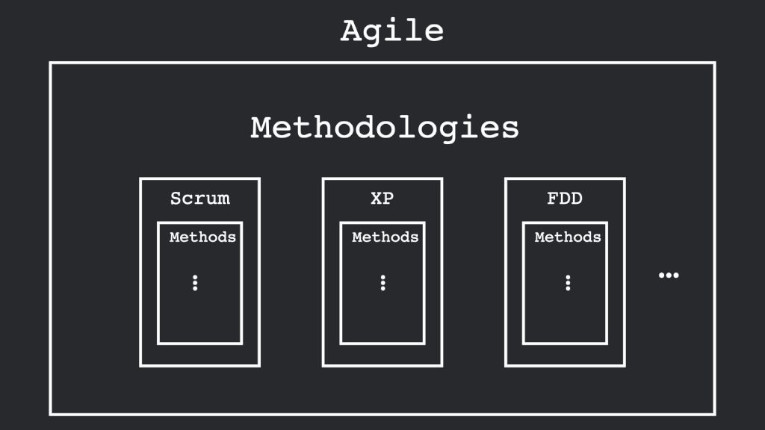Agile methodology is not defined by a set of specific development techniques. In fact,
Agile is a group of methodologies that demonstrate a commitment to feedback cycles and continuous improvement.
Often the concept of method and methodology ends up confusing an understanding of the whole concept. I admit that before writing this post I also had my doubts, but I managed to reach a final understanding. Understand that:
Method is simply a research tool, a component of research – for example, a quantitative method such as interviews. Methodology is a system of methods used in a particular area of study or activity.
The image below explains where the set of agile methodologies and each methodology fits into the model.

Agile Methodology is an iterative approach to project management and software development that helps teams deliver value to the customer faster and with less headache.
Instead of betting everything on a single release, an agile team delivers work in small increments that can be used. Requirements, plans and results are continuously evaluated so that the team has a mechanism to respond quickly to possible changes or updates.
The original Agile Manifesto did not prescribe any kind of initial rule, such as two-week iterations or an ideal team size. It simply established a set of 4 core values.
How you and your team will work on these values – whether you use Scrum or mix elements of Kanban and XP – depends entirely on you and your team.
The agile model adopts an iterative development, and each iteration, also known as a sprint, is designed to be small and manageable to be delivered in a short period of time, usually one or two weeks.
The agile process is a group of development processes, and its main reason is to remove/avoid activities that may not be necessary for the project and remove anything that is a waste of time and effort.

Teams generally choose to use agile methodology because it allows them to respond quickly to market changes or customer feedback. Planning and implementation in small and frequent increments allows your team to get feedback on each change and integrate it into future plans at a minimal cost.
But it’s not just a numbers game – first and foremost, it’s about people. As described by the Agile Manifesto, human interactions are more important than following processes to the letter.
Collaborating with clients and teammates is more important than pre-defined rules. And delivering a functional solution to a customer’s problem is more important than hyper-detailed documentation.
But if we needed to list the benefits of agile methodologies, they would be:
The most popular and common examples are:
Teams usually choose one or two methods. The most commonly used methods are Scrum and XP, which fit together very well.
Let’s talk about them in a next article.
The agile methodology is an effective process for teams seeking a flexible approach to software development. The agile methodology can be implemented for any enterprise that requires a plan that needs to value collaboration with the client, teamwork, responsive changes and, of course, quality results.
Como a metodologia ágil melhorou a maneira de trabalhar de sua equipe? Não se esqueça de compartilhar suas dicas conosco!
Don’t forget to subscribe to our newsletter to receive all the news. See you next time.
Leave a Reply